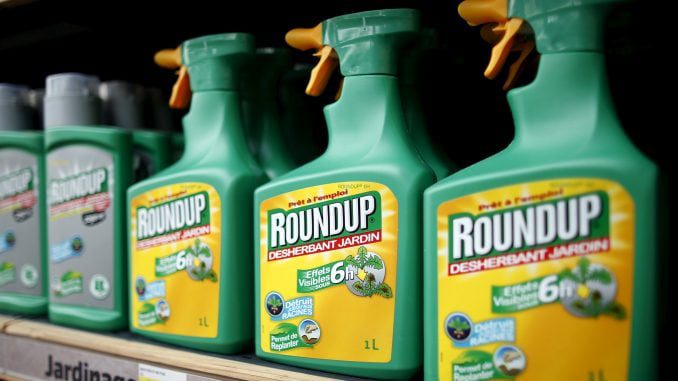
LONDON When Aaron Blair sat down to chair a weeklong meeting of 17 specialists at the International Agency for Research on Cancer in France in March 2015, there was something he wasn’t telling them.The epidemiologist from the U.S. National Cancer Institute had seen important unpublished scientific data relating directly to a key question the IARC specialists were about to consider: Whether research shows that the weedkiller glyphosate, a key ingredient in Monsanto’s best-selling RoundUp brand, causes cancer.Previously unreported court documents reviewed by Reuters from an ongoing U.S. legal case against Monsanto show that Blair knew the unpublished research found no evidence of a link between glyphosate and cancer. In a sworn deposition given in March this year in connection with the case, Blair also said the data would have altered IARC’s analysis. He said it would have made it less likely that glyphosate would meet the agency’s criteria for being classed as “probably carcinogenic.”But IARC, a semi-autonomous part of the World Health Organization, never got to consider the data. The agency’s rules on assessing substances for carcinogenicity say it can consider only published research and this new data, which came from a large American study on which Blair was a senior researcher, had not been published.The lack of publication has sparked debate and contention. A leading U.S. epidemiologist and a leading U.K. statistician both independent of Monsanto told Reuters the data was strong and relevant and they could see no reason why it had not surfaced.Monsanto told Reuters the fresh data on glyphosate could and should have been published in time to be considered by IARC, and that the failure to publish it undermined IARC’s classification of glyphosate. The legal case against Monsanto, taking place in California, involves 184 individual plaintiffs who cite the IARC assessment and claim exposure to RoundUp gave them cancer. They allege Monsanto failed to warn consumers of the risks. Monsanto denies the allegations.The company also goes beyond saying the fresh data should have been published. It told Reuters the data was deliberately concealed by Blair, but provided no specific evidence of it being hidden.Blair told Reuters the data, which was available two years before IARC assessed glyphosate, was not published in time because there was too much to fit into one scientific paper. Asked whether he deliberately did not publish it to avoid it being considered by IARC, he said that was “absolutely incorrect.” He said a decision not to publish the glyphosate data had been taken “several months” before IARC chose to conduct a review of the chemical.The National Cancer Institute also cited “space constraints” as the reasons why the new data on glyphosate was not published.AT ODDSThe absence of the data from IARC’s assessment was important. IARC ended its meeting in 2015 by concluding that glyphosate is a “probable human carcinogen.” It based its finding on “limited evidence” of carcinogenicity in humans and “sufficient evidence” in experimental animals. It said, among other things, that there was a “positive association” between glyphosate and blood cancers called non-Hodgkin lymphoma. IARC told Reuters that, despite the existence of fresh data about glyphosate, it was sticking with its findings.The agency’s assessment is at odds with other international regulators who have said the weedkiller is not a carcinogenic risk to humans. It led to a delay in Europe on a decision on whether to relicense or ban EU-wide sales of pesticides containing glyphosate. That decision is still pending. In the meantime, some countries have tightened restrictions on the weedkiller’s use in private gardens and public spaces and on crops before harvest.In the United States, a California judge took the IARC assessment into account in a separate legal case in March when ruling that the state can require RoundUp to carry a warning label that it may cause cancer. Monsanto is now facing further litigation from hundreds of plaintiffs across the United States who say glyphosate gave them or their loved ones non-Hodgkin lymphoma, citing the IARC assessment as part of their claims.Yet if the IARC panel experts had been in a position to take into account Blair’s fresh data, IARC’s analysis of the evidence on glyphosate would have been different, Blair acknowledged in the court documents reviewed by Reuters.The unpublished research came from the Agricultural Health Study, a large and significant study, led by scientists at the U.S. National Cancer Institute, of agricultural workers and their families in the United States. Asked by Monsanto lawyers in March whether the unpublished data showed “no evidence of an association” between exposure to glyphosate and non-Hodgkin lymphoma, Blair replied: “Correct.”Asked in the same deposition whether IARC’s review of glyphosate would have been different if the missing data had been included, Blair again said: “Correct.” Lawyers had put to him that the addition of the missing data would have “driven the meta-relative risk downward,” and Blair agreed.Scott Partridge, Monsanto’s vice president of strategy, told Reuters the IARC glyphosate review “ignored multiple years of additional data from the largest and most comprehensive study on farmer exposure to pesticides and cancer.”The Agricultural Health Study was particularly pertinent, he said, because it examined real-life human exposure to glyphosate, whereas much of the scientific research IARC analyzed involved laboratory tests on rodents.IARC told Reuters that its evaluations follow strict scientific criteria and that its carcinogen classification system “is recognized and used as a reference all around the world.” It reiterated that in the interests of transparency it considers only published data.Reuters asked two independent statistical experts to review the data, which has still not been published, though the National Cancer Institute told Reuters researchers are currently working on an updated analysis of it. Neither of the two experts had seen the data before and both said they had no conflict of interest over glyphosate.David Spiegelhalter, a professor of the Public Understanding of Risk at Britain’s University of Cambridge, said there was “no apparent scientific reason” for not publishing the data. Bob Tarone, a retired statistician who worked alongside Blair and others at the National Cancer Institute for 28 years before moving to the for-profit International Epidemiology Institute, said he could find “no ready explanation in terms of the available scientific evidence” for the data not to have been published.Tarone had already raised the issue in a little-noticed paper in the European Journal of Cancer Prevention last year. He wrote that IARC’s classification of glyphosate as probably carcinogenic to humans was the result of “a flawed and incomplete summary” of the evidence.In an email to Reuters, IARC declined to say whether Blair informed IARC staff about the unpublished data, whether he should have, and whether that data might have changed IARC’s evaluation of glyphosate had it been published in time. The agency said it had no plans to reconsider its assessment of the chemical.NONSELECTIVE HERBICIDEGlyphosate is what’s known as a non-selective herbicide, meaning it kills most plants. Discovered by the Monsanto chemist John E. Franz in 1970, glyphosate is no longer under patent, is supplied by numerous companies and is now the world’s most widely used weedkiller, deployed in agriculture, forestry and domestic gardening. Monsanto and other companies have developed genetically engineered seeds that can tolerate glyphosate, allowing farmers to apply it to entire fields without destroying crops.The safety of the chemical has been under scientific and regulatory scrutiny since the 1980s. The U.S. Environmental Protection Agency and other international bodies, including the European Food Safety Authority, Health Canada’s Pest Management Regulatory Agency, New Zealand’s Environmental Protection Authority and Japan’s Food Safety Commission, have kept it under regular review, and all say glyphosate is unlikely to cause cancer in humans.But it is not settled science, and researchers across the world continue to study glyphosate measuring traces of it in water and foods, exposing lab rats to it, and monitoring possible health effects in people who have used it year after year in their work.One of the largest and most highly regarded studies to examine effects of pesticide use in real life is the Agricultural Health Study, a prospective investigation of about 89,000 agricultural workers, farmers and their families in Iowa and North Carolina. Since the early 1990s, it has gathered and analyzed detailed information on the health of participants and their families, and their use of pesticides, including glyphosate.AHS researchers have published numerous studies from their data. One paper looking at glyphosate and possible links with cancers was published in 2005. It concluded that “glyphosate exposure was not associated with cancer incidence overall.” Since then, more data has been collected, adding statistical power to subsequent AHS analyzes.In early 2013, Blair and other researchers began preparing new papers with updated AHS data on lymphoma and pesticides, including data on glyphosate. Reuters reviewed drafts dated February 2013 and March 2013, and asked Spiegelhalter and Tarone to examine them. They said the papers, while still in the editing process, were in relatively advanced manuscript form. The drafts contain notes in the margin and suggested changes signed “AEB,” Blair’s full initials.After studying the draft papers, Tarone said the unpublished figures show “absolutely no evidence whatsoever” of an increased risk of non-Hodgkin lymphoma because of exposure to glyphosate.Spiegelhalter told Reuters: “In the drafts I saw, none of the herbicides, including glyphosate, showed any evidence of a relation” with non-Hodgkin lymphoma. He noted that the study was statistically strong enough to show a relationship for other pesticides so had there been any link to glyphosate, it should have shown up.In his legal testimony, Blair also described the Agricultural Health Study as “powerful” and agreed the data showed no link.But these draft papers were never published, even though Blair told Monsanto’s lawyers in March that the Agricultural Health Study was robust and statistically well-powered, and told Reuters the research was important for science and the public. Email exchanges between Blair and his fellow researchers in 2014 also show they were keenly aware there would be scientific and public interest in fresh AHS data.On Feb. 28, 2014, Michael Alavanja, a co-lead author of one of the draft papers, sent an email to another AHS co-researcher, copying the message to Blair. It noted that the research was “important to science, public health, IARC and EPA.”In the same email, Alavanja referred to the findings on non-Hodgkin lymphoma, or NHL. He wrote: “It would be irresponsible if we didn’t seek publication of our NHL manuscript in time to influence IARCs (sic) decision.”Yet the new AHS data on glyphosate and lymphoma did not surface.Instead, a revised version of one of the 2013 draft papers prepared by Blair and other researchers appeared in a journal called PLoS One in October 2014. It did not include the data on herbicides, of which glyphosate is one.This was unusual. Since 2003 AHS researchers had published at least 10 papers using different rounds of updated data to explore possible links between pesticides and specific diseases. And each one included all four pesticide classes: fungicides, fumigants, insecticides and herbicides.Alavanja was one of the authors of the paper published in PLoS One in 2014. He said he and other authors and senior scientists at the National Cancer Institute decided to remove herbicides from that analysis primarily because of “the issue of statistical power and the need for a comprehensive evaluation of glyphosate and all cancers.”Blair told Reuters the data on herbicides, including glyphosate, had been removed “to make the paper a more manageable size.” He gave a similar answer to the lawyer acting for Monsanto, who repeatedly asked in the legal deposition why the data was not published. Blair testified that the paper “went through many iterations.” He said he could not recall when the glyphosate data was removed, but “we decided to remove it because … you couldn’t put it all into one paper.”Monsanto argues that the data was not published because it showed no link between glyphosate and non-Hodgkin lymphoma.Tarone said the absence of herbicide data in the published 2014 paper was “inexplicable,” noting that volume of data had not been an issue in any previous published papers. He said updated AHS data and analyzes on herbicides “should be published as soon as possible” to allow “a more complete evaluation of the possible association between glyphosate exposure and NHL risk in humans.”Reuters asked nine other scientists listed as authors on the two draft papers of 2013 why these drafts had never been published. Some were unavailable for comment, and others referred questions to Laura Beane Freeman, who was a co-author on the draft papers and on the 2014 PLoS published study, and is the National Cancer Institute’s current principal investigator of the AHS.In an email to Reuters, Freeman and a spokesman for the institute said: “After reviewing early drafts of the manuscript, it became clear that it would be impossible to do a thorough evaluation of all major pesticide groupings due to the sheer volume of information that was important to include.”They said the decision to separate the results for herbicides, including glyphosate, allowed the scientists “to present more thorough evaluations” of the remaining pesticides. An updated study on glyphosate is under way, Freeman said.CULTURE CLASHDespite IARC’s modest size and budget, its monographs assessments of whether something is a cause of cancer often catch the eyes and ears of policymakers and the public. Recent IARC monographs have included judgments that red meat is carcinogenic and should be classified alongside arsenic and smoking, and that coffee, which IARC previously said might cause cancer, probably is not carcinogenic.The agency takes a different approach to many other regulators in two important ways. First, it says it assesses “hazard” the strength of evidence about whether a substance or activity can cause cancer in any way, whether in a laboratory experiment or elsewhere. It does not assess the “risk” or likelihood of a person getting cancer from everyday exposure to something. Second, in general it only considers research that has been published in peer-reviewed scientific journals.IARC considered around 1,000 published studies in its evaluation of glyphosate. But only a handful of those were cohort studies in humans the kind like the Agricultural Health Study and the most relevant to real-life situations such as people working with glyphosate in agriculture.The differing judgments on glyphosate by IARC and other regulators have stoked clashes on both sides of the Atlantic. In the United States members of Congress have launched investigations into American taxpayer funding of IARC. They have yet to reach any conclusions.In Europe, the battle centers on the looming decision about whether to relicense glyphosate for use in the European Union. The European Commission has said it wants EU member states to come to a decision by the end of 2017. Politicians will need to weigh the opinions of IARC and other scientific bodies when they decide whether or not to accept a commission proposal to extend glyphosate’s marketing license by 10 years.It remains unclear whether the AHS data will see the light of day in time to be considered. Blair said he thought publishing the glyphosate data would be important and that his former colleagues at the NCI were working on it. The NCI’s Freeman said her team is currently “drafting a manuscript on this topic.” She said the new study “will explore the effects of glyphosate exposure in greater depth than a publication that includes multiple pesticides” and would, she hoped, be submitted “to a peer-reviewed journal in the coming months.”Alavanja said a draft paper “should be available for submission to an appropriate scientific journal sometime later this year,” but that a publication date “is very difficult to predict.”




